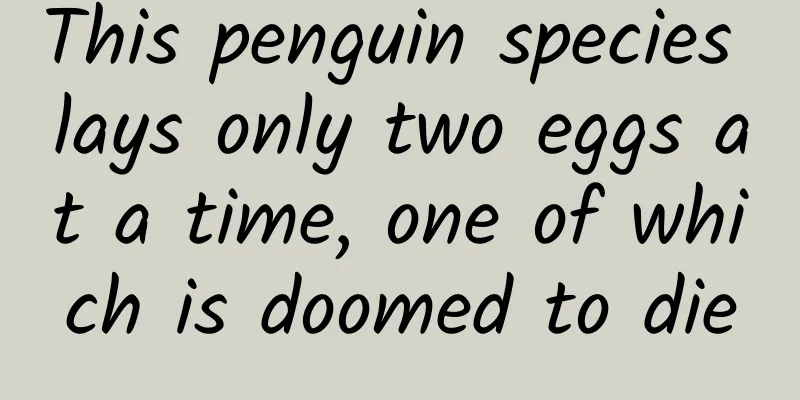This penguin species lays only two eggs at a time, one of which is doomed to die

|
In the movie "Happy Feet", there is a penguin that looks a bit unique. Its bright yellow eyebrows reach the sky, just like the tassels on the helmets of ancient soldiers. Hence the name: Eudyptes sclateri. Image source: Stills from "Happy Feet" In the movie, the penguin appears on the Antarctic continent, but in fact, they do not breed in Antarctica, but on Antipodes Island and the Bounty Islands, about 2,500 kilometers away from the Antarctic continent. In this article, let's take a look at what else is special about this penguin besides its "upturned eyebrows". Antipodes Island, Image source: Wikipedia 01 Abandoned Island The Forgotten Penguin The Maori call Antipodes Island Moutere Mahue, which means the abandoned island (the island is about 750 kilometers off the southern coast of New Zealand), which shows how isolated and remote the island is. Because of this, the penguins on the island have long been forgotten, and they are the least studied of all penguins. No scientists have come to the island specifically to study them. It wasn't until September 1998 that a group of scientists spent three and a half days sailing to this isolated island in the South Pacific to study the endangered penguins there. Scientists and penguins swimming in the sea. Image source: New Zealand Automobile Association The scientists stayed on the island until November, the penguins' breeding season, and observed them 12 hours a day. They painted yellow paint on the backs of 270 penguins to mark and track them. The scientists also marked their nests and measured the size of some eggs with calipers. During this time, the scientists observed the penguins' behavior, seeing how they courted, mated, laid eggs and incubated them. Crow-eye penguins on Antipodes Island. Photo credit: Tui De Roy/NPL/Minden Pictures 02 Why does one egg never hatch? There is a strange phenomenon that puzzles scientists: almost always one of the two eggs laid by the penguin will not hatch, with the probability of non-hatching as high as 98%. The browed penguin always lays two eggs, and the second one is bigger than the first one. Image source: NZ birds online The first egg (egg A) is usually laid in early October and is relatively small in size. The second egg (egg B) is laid about 5 days later and is larger in size. The difference in volume between the two eggs is very significant. According to statistics, Egg B is 85% heavier than Egg A and 79% larger in volume. The difference in volume and weight between Egg A and Egg B. Image source: Reference [1] In fact, it is not just the browed penguin. Other penguins also have one egg that is larger than the other. For example, another crested penguin, the Eudyptes robustus, also has one egg that is larger than the other. Two eggs of the yellow-browed penguin on Sessima Island. Egg B is larger than egg A. Image source: Reference [2] It's just that this size difference is most obvious in the browed penguins. For small eggs, their parents generally don't take good care of them, so small eggs will either be accidentally broken or roll out of the nest. The penguin mother will deliberately peck at it and squeeze it out of the nest. Without the appropriate temperature for incubation, these lonely A eggs will eventually rot and die. Even if scientists intervened in the incubation of penguin eggs, they could not save the lives of the small eggs. Scientists conducted an experiment on the island. They added a circle of stones around 14 nests to see if they could protect the eggs from rolling out. Another 28 nests were not protected by a circle of stones and were used as a control group. Although the A eggs protected by scientists survived a little longer, the final fate of the small ones remained unchanged, and they still died, because those small ones that were not squeezed out of the nest still did not receive the warm care of their mothers. In the experiment, the protected eggs are more likely to break, while the unprotected eggs are more likely to be squeezed out of the nest. Image source: Reference [1] It is obvious that the mother penguin did it on purpose. She gave up the small eggs and spent more time on hatching the large eggs, which led to the small eggs always dying. 03 Little Guy: Why am I always the one who gets hurt? Why didn't the first egg get any love? Most of the behaviors of animals are for survival, and the reproduction behavior of penguins must be related to survival. The place where penguins lay eggs is often far away from where they forage. It may be that they cannot bring back enough food to feed two chicks, so they can only choose one to give enough care and nutrition. Wouldn't it be fine to just lay one egg? Why do you have to lay two eggs? First of all, the penguin must want to have a big egg, so that the chicks born are healthier and more likely to survive. But the first egg they lay is always small, so they have to lay the second egg to ensure it is a big egg. Image source: Nz birds online Why is the first egg always small? Scientists speculate that this is because the sea water is cold when the penguins cross the sea for about 2,500 kilometers, and the physical exertion of the female birds limits the production of yolk. Therefore, when they arrive on the island and begin to reproduce, the first egg laid is always small. The environment on the island is definitely much better than that on the sea. After a while, the female bird's physical strength begins to recover, and after the yolk develops normally, the second egg will develop normally, so it will be larger. Finally, penguins' preference for large eggs means that one of the eggs they lay is always abandoned. Image credit: Tui De Roy/NPL/Minden Pictures Of course, this is all speculation by scientists, and there is still a lot of research to be done on the penguins on this remote island. For a species, if almost all individuals choose to "save the big ones instead of the small ones", it certainly has nothing to do with whether it is selfish or not. If it must be said that it is selfish, it can only be said that it is in nature. References: [1] https://journals.plos.org/plosone/article?id=10.1371/journal.pone.0275106 [2] Miskelly C, Carey P. Egg-laying and egg-loss by erect-crested penguins. In: Miskelly CM, Carey PW, Pollard SD, editors. Antipodes Island expedition. Christchurch: University of Canterbury report; 1990. p. 12–16. Produced by | Science Popularization China Author: Su Chengyu Producer|China Science Expo Submitted by: Computer Information Network Center, Chinese Academy of Sciences The cover image and the images in this article are from the copyright library Reproduction of image content is not authorized |
<<: Dry and itchy skin after showering? You may be doing these 5 things wrong
>>: Snow leopards, big cats active in the snowy mountains
Recommend
AiKop | "Cats" on the big ship
One, two, three...prepare to sing Let's learn...
The event planning effect is poor. How to improve it efficiently and achieve growth?
Event planning and operation are commonplace for ...
Insights and solutions for the automotive industry during the epidemic
At the beginning of the Year of the Rat, a sudden...
"Highly Disseminated" Fission Poster Design Routine
Visual aesthetics is prevalent nowadays, and visu...
Advanced event planning: 4 steps to control event costs
An activity is generally divided into four parts ...
Recommended places to drink tea in Kunming that I experienced yesterday
Kunming tea tasting has its own studio. Recommend...
Let’s take a look at the “marketing madman” Luo Yonghao, he is really tough!
In the past two days, there has been new progress ...
Today's headlines have come up with a new advertising method, come and watch~
At present, embedding information flow ads may be...
“A Bite of China 4” reveals: When food meets physics, it’s amazing!
"A Bite of China" presents Chinese food...
Cook said at the hearing that all developers are treated equally, but the evidence shows otherwise
Apple CEO Tim Cook testified before the U.S. Cong...
MBTI 16-type personality test becomes a social label? Why are all those who have taken it accurate?
When you read other people’s self-introductions o...
2019 Tik Tok and Kuaishou User Research Report!
Kuaishou and Douyin, as the two representative pl...
This app can make the iPhone X's bangs disappear
The much-anticipated iPhone X has begun shipping....
The operation and promotion of Super Course Schedule
1. App Market ASO In terms of the overall environ...









